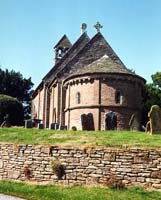| |
 |
Kilpeck (Herefordshire) Church of St Mary and St David |
At the time of Domesday Book (1086) Kilpeck was held by William Fitz Norman who built a motte and bailey castle here. His son founded a Benedictine Priory which he granted to Gloucester Abbey. The wealth of the priors probably accounts for the lavish decoration of the church which was built c. 1140. Employing good quality local sandstone, it consists of a nave and apsed chancel.
The apse has a rib-vaulted roof decorated with zig-zag and there are four carved heads at the apex. The chancel arch also has zig-zag and on each shaft are figures of three apostles, one above the other.
The south doorway is rightly famous for its vitality and inventiveness. The main arch is carved with beak heads, monsters and an angel at the apex. The hood-mould has a chain motif, each link containing a beast, fish or monster. The door jambs bear the entwined bodies of snakes and on one of the shafts are carved two long wiry warriors, while on the other is foliage. The capitals are carved with animals and a grotesque head. On the tympanum a vine scroll is depicted.
There is a richly carved west window and dragon heads project from the west wall. Finally, the corbels depict a splendid range of grotesque heads and animals. Kilpeck provides some of the best examples of the Herefordshire School of sculpture in which the influence of French styles and that of the Scandinavian Ringerike style can be clearly seen.
Bibliography
Impey, E., 1997. 'The buildings on the motte at Kilpeck castle, Herefordshire', Archaeologia Cambrensis 166, 101-8
King, J., 1995. 'The parish church of Kilpeck reassessed', in Medieval Art and Architecture at Hereford Cathedral, British Archaeological Association Conference Transactions, 82-93
Pevsner, N., 1963. The Buildings of England, Herefordshire (London, Penguin), 201-3
Thurlby, M., 1999. The Herefordshire School of Romanesque Sculpture (Almeley)